More than 3O % of Schela commune's villagers are named after important saints in the Orthodox calendar: Vasile, Ion, Gheorghe, Constantin, Elena, Maria, Petru, Pavel, Ilie, Dumitru, Nicolae, Mihail. In their respective red-letter day, they always celebrate their name-day. Plus, those who have the first name Maria, Mariana, Maricica, Marian, Maricel, Marin and Marinica celebrate their name-day twice a year, first on the 15th of August, then on the 8th of September. During one's name-day, relatives and friends may visit that person without any invitation. It is very rarely that villagers celebrate their name-day outside their house, in a restaurant. In these festive days, peasants usually don't go to work the field. Villagers who don't work in agriculture and have a collegue whose name-day it is, usuallly stop working at mid-day. For these people, the party begins at lunch break. Colleagues of the celebrated person, collect money and buy him a present. The celebrated person offers snacks and drinks to his colleagues on the occasion of his name-day. The lunch break, turned into a party, lasts until the end of the work day. In the evening the celebrated person has another party to handle at his home.

Munteanu Sandel and Munteanu Nicu celebrating St. Gheorghe on the field
St. Vasile - 2 January
St. Ion - 7 January
St. Gheorghe - 23 April
Sts.Constantin and Elena - 23 May
Sts.Petru and Pavel - 29 June
St. Ilie - 20 July
St. Maria - 15 August
St. Maria - 8 September
St. Paraschiva - 14 October
St. Dumitru - 26 October
Sts. Mihail and Gavril-15 November
St. Andrei - 30 November
St. Nicolae - 6 December

1, 2 January - New year
6 January - Epiphany
24 January - Union Day
1 March - Martisorul
8 March - Women's Day
1 April - Fool's Day
27, 28 April - Easther
1 May - Labour Day
1 June - Child Day
5 June - Ascension Day
30 November- St. Andrei, protector of Romania
25, 26 December - Christmas

Marin Doru Gabriel, always invited to parties
On the first of January people in Romania celebrate Saint Vasile's day.
Apart from parties organised by people who carry this Christian name,
on this first day of the year, children go to villagers' houses
for a custom called "the seeding".
Once entered in villagers' houses, children spread out seeds of
wheat or rice, wishing a copious year to the landlord.
As thanks for being "seeded", landlords offer them money .
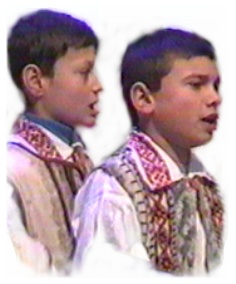
Adrian Enache and Costel Minea going with "the seeding"

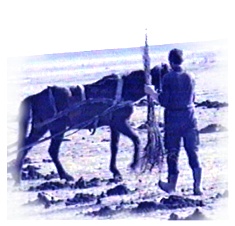
Horse, animal celebrated in Schela on the occasion of Epiphany
Every 6th of January, villagers celebrate Epiphany. Priests hallow wells, sources of water and the Lozova rivulet. Villagers take a cup of holy water from priests and sprinkle it all over their house. They believe that this holy water keeps away bad spitits, deseases and everything which is ill-fated. On the Epiphany Day there's an old custom in Schela village which appears to have Tartar roots: young horses are sprinkled with holy water then a horse racing is organised in the village.
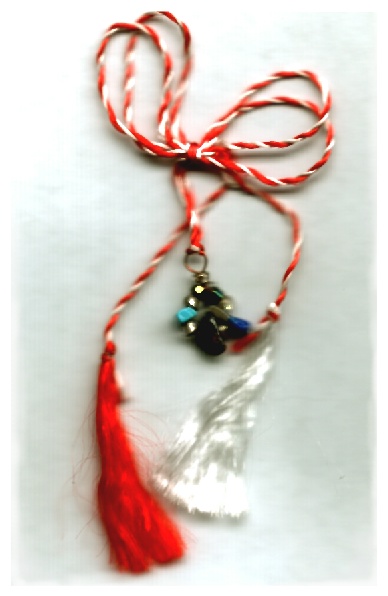
A Martisor amulet
First of March is the Martisor Day or the first spring day.
Men and boys offer to the women and girls they apreciate a small
badge.
This badge is called " the Martisor amulet".
It is attached on the lapel of dresses by a pin and a red and white thread.
For a week, girls proudly wear the Martisor amulets they had received.
They say that a girl is apreciated by the boys depending on how many
Martisor amulets she's been offred on the Martisor Day.

Between 1st and 9th of March there's the "hags" days. A hag is a sort of witch that has a day when she can influence the weather. In the previous week, everybobdy choose a speciffic day in Hags' period, deciding that this day will be his/her hag. Tradition says that in the next period the mood of a person will depend on the weather of the day s/he chose to be her/his hag. If there's a sunny day, s/he will be happy all year long.
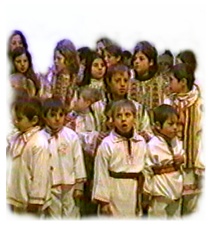
Children in Schela in traditional cloths
Every 8th of March Romanian people celebrate Woman's Day.
Men offer flowers and small presents to women.
It is expected that men behave lovingly
with their wives and/or with their lovers in this very day.
In the latest years Woman's day's shows have been
organised in Schela village, consisting of poems reciting,
singing and dancing.
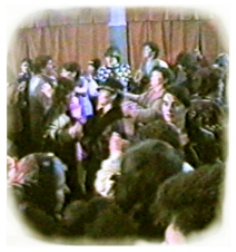
Party organised at Cultural Club on Woman's Day occasion

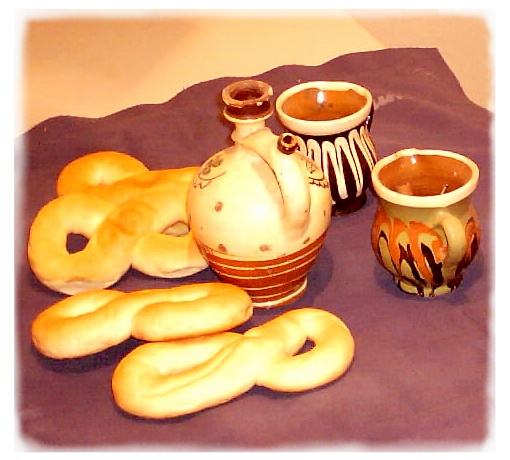
Knot-shaped bread cooked for Martyrs Day
Every 8th of March people celebrate Day of the 40 Martyrs.
A day before women cook knot-shaped bread, which they grease with
honeybean and nut kernel pounded.
On Martyrs' Day they visit their poor reltives and offer these cakes together with
other food, which they generally call "impartituri"(charities).
These are given in memory of a deceased relative who used to be close to donor.
This is also the day when men get drunk, invoking the old Christian tradition
of the 40 glasses of wine drunk in the honour of the 40 martyrs.
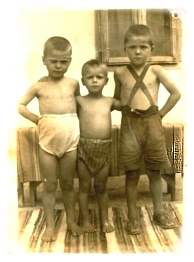
Lica Sirbu, Mimi si Culai Apostol, in Negrea, on Flowers Day, in 1945
Every 2O April Romanian people celebrate Flowers' Day.
Villagers hung red and white ribbons on flowers' stem or on trees' branches
in their courtyard in order to show their appreciation to plants.
This is also a day when Romanians belivers exclusively eat fish.
Villagers in Schela buy fish from Galati city as in the neighbourhood
there are no fish breeding farms.
People in the region usually cook grilled herring this day.
Romanian belivers who are called after names of flowers
celebrate their name-day.

40 days before this religious celebration, many people in
Schela and Negrea villages keep the lent(vegetarian diet).
Couple days before Easter, villagers slaughter lambs or buy
lamb meat.
They cook haggis and salt lamb meat or they carve lamb meat
for roast meat and sour soup.
They always paint at least 20 eggs and cook sponge cake.
In Easter Eve, called the Night of Resurection,
almost every villager go to church.
Priests keep Resurection services and symbolically light
a candle at midnight.
Belivers standing next to priests light their candle from
prists' candles.
Then they turn around and offer their candle to others
in order everybody can light their candles too.
This ritual is called "giving light from light".
The next morning, which is called the first day of Easter,
women go to church, bringing in a basket samples of food they
cooked on the occasion of Easter: sponge cake,
red painted eggs and a bottle of wine.
Priests keep a special service for blessing the food and absolve belivers
from the lent, as they may eat again meat and animal products.
Food that women bring to church is given as charity to poor people
of communities.
First day of Easter children use to have lunch with their parents.
Second day of Easter godsons use to visit their godfathers.
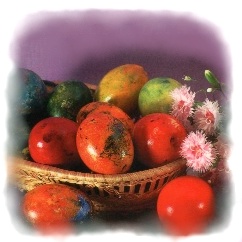
Red painted eggs


Girls singing in a school performance
(Sinzienele or Dragaica)
Sinzienele are bad pixies of the night in Romanian folk tradition.
People think these pixes could influence future marriages.
Every 24 june, in the Sinziene's night, unmarried girls cut
petals of a thistle flower.
Then they keep that flower in a glass of water.
They say that the faster petals grow back at the thistle she
looks after, the bigger her chances are
to marry the man she loves.
Every 14 October villagers celebrate Schela commune's Day.
Priests in both villages celebrate a service in the honour of the
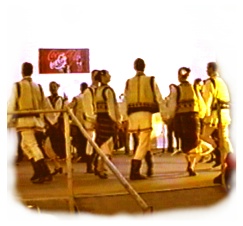
spiritual patron of the commune, saint Paraschiva. Last world war veterans talk to kids in schools about the past of the villages. Mayor keeps a speach about future plans of the Schela commune to the audience gathered in the Cultural Club. Then comes a performance offered by pupils from local schools, the folk dance team of Schela and guest artists. The show includes the yearly awarding of the most beautiful young ladies in Schela. Afterwards villagers drink beer and eat grilled minced meat rolls.

People celebrate Harvest Day in Schela in second wednesday of September.
Wednesday is also market day in Schela village.
On Harvest Day, local shopkeepers are allowed by the Mayoralty to open stands
in the market.
They sell grilled minced meat rolls, sheep pemmican and must- unfermented wine.
Villagers celebrate Harvest Day in the market place.
It is an oppurtunity to meet their relatives and friends.
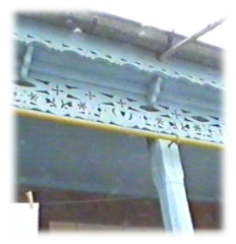
Typical ornament of houses in Schela commune
Saint Nicolae's Day
On the 6th of December Romanian believers celebrate
Saint Nicolae's day.
People having their first-name Nicolae, Niculina and Nicoleta
are celebrated.
On Saint Nicolae's Eve members of families mutually offer
themselves presents hiding these gifts in boots.
Children polish their boots and prepare them for gifts before
going to bed.
They believe Saint Nicolae comes at midnight and
brings presents for them.
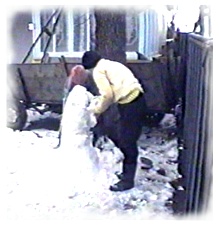
Family making a snow man in their courtyard

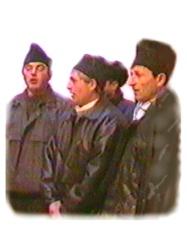 Men in Schela singing carols
Men in Schela singing carols
Before Christmas many people in schela use to advent (keep a vegetarian diet). Some days before the 25th of December women cook traditional cakes called "turte". These are superposed thin pie leaves, dipped into a sweet syrup. Between pie leaves they sprinkle roast and pounded nuts. Children go to villagers houses and sing Christmas carols. People receive them on the verandah, listen to them and recompense them with nuts, pretzels or money. Parents adorn Chrismas trees for their children.
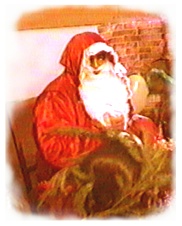
Frangulea Ionel playing Santa Claus at the kinder-garten
Santa Claus
On the 24th of December women visit their poor relatives and neighbours.
They offer them food they cooked as charity: "turte" cakes, dryed plums traditional dish
and force-meat rolls in cabbage.
The night between 24-25 December men in families dress in Santa Claus
and bring presents to their children.
Grown-up people mutually offer themselves gifts, putting them under crowns of
Christmas trees.

Pigs sacrifying
During Christmas holidays villagers use to slaughter their pigs in courtyards. Owners send for 2-3 friends to help. Usually one of them is skilled in pigs slaughtering. Pigs are sacrified, singed and carved in courtyards. Afterwards landlords thanks to their friends for having helped and offer them a meal called "pomana porcului"(pig's charity). This meal consists of a traditional dish called "tochitura": musles and pork organs fryed in edible oil. Next days are destined for preparing traditional pork food for New year's Eve party: sausages, blood pudding, mosaic salami, leberwurts, pig's trotters and force-meat rolls in cabbage.
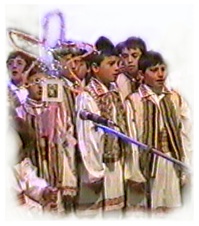
Children singing the "Steaua" carol
The "Plugusorul" wishes
On the 31st of December children gather together in groups of 3-10 and go to villagers houses for giving them best wishes. The custom has 2 distinct components: the "Plugusoru"(plough) wishes and the "Capra"(she-goat) ritual. "Plugusoru" is a wish said in rhymes, by turn, accompanied by gingle bells and horse whips noise. In this ritual, gingle bells does not symbolize church bells and have nothing to do with religion. Gingle bells represent bells that people used to put to oxen which formely carryied tools for plough the land. The "plugusoru" rhyme wishes are meant to bring rich harvest, health and good luck to villagers for the next year.
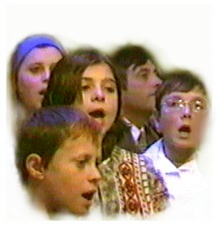
Chidren saying "Plugusoru" rhyme wishes

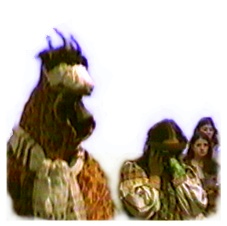
Voinoiu Florin playing the "Capra" (she-goat) role
The "Capra"(she-goat) ritual
"Capra" is a short folk play with archaic reek. It takes at least 5 children to perform it. They mask themseves and dress in multi-coloured cloths. Then they all go to villagers' houses. An actor recites the story in a rhythmic tempo. Others accompany him with improvised percution instruments. She-goat dance is a parody of women's freaks. The script is simple: she-goat (freak lady) pretends to be sick before her family. But when a male goat pass by she forgets about her supposed illness and suddenly becomes cheerful. In the last years The Cultural Club in Schela organizes public performances on the occasion of Winter holidays, showing these archaic traditions on stage.
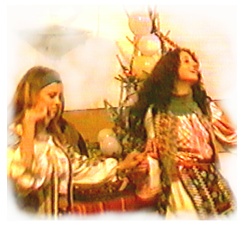
Petre Ilinca and Maria Pavalache dancing in front of Christmas tree.
Wild party
Villagers in Schela use to party on New Year's Eve in their
homes or their friends' homes.
For most of them this is the wildest party in whole year.
They let themselves go: drink, sing and dance without restraints.
Few villagers in Schela use to go to restaurants that night.
Hosts always prepare a very scrumptious meal, but apart from
other parties, guests bring also food and drinks.
Younger families dance all night long.
Elder families chat, sing, eat and drink until morning comes.
